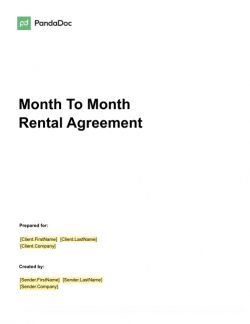South Dakota Month-to-Month Lease Agreement
A South Dakota month-to-month lease agreement outlines the legal duties between landlords and tenants in the tenancy. These short-term leases emerge as a top option for renters as they enjoy legal protection without a long-term commitment. Even better is that they auto-renew until either party issues a termination notice.

Legal Aspects of a Month-to-Month Lease Agreement in South Dakota
Navigating the intricacies of a South Dakota month-to-month lease agreement requires a nuanced understanding of the legal landscape. In this Midwestern state, the legal aspects of month-to-month leases form the backbone of landlord-tenant relationships.
Lease Termination & Renewal
- A landlord or tenant in South Dakota can terminate a month-to-month lease for any reason.
- To terminate, a written 30-day notice must be provided by either party before the last day of the current rental month.
Rent Increases
- The landlord may increase the monthly rental rate at any time with 30 days written notice given to the tenant.
- There’s no limit on the amount the landlord can raise rent.
- The new rental rate will become effective on the first day of the month following the 30-day notice period.
Security Deposit
- The landlord can require a security deposit to be paid upon signing this lease agreement. This amount must be at most one month’s rent, the maximum permitted under South Dakota law for unfurnished units.
- The landlord shall return the full security deposit to the tenant within two (2) weeks after the tenant vacates the property unless there are deductions for damages or defaults under the lease. If any deductions are taken from the deposit, the landlord will provide the tenant with a written itemized statement explaining the deductions within two (2) weeks.
- If the tenant requests in writing, the landlord must provide a complete and detailed written accounting of all deductions from the security deposit within 45 days of receiving the request. Landlords can’t deduct for normal wear and tear or pre-existing conditions.
- According to state law, the tenant must provide the landlord with a forwarding address upon vacating to receive the refunded security deposit.
Tenant Rights
- Tenants have the right to a legally binding contract upon signing the lease, holding both parties accountable for fulfilling its terms.
- Tenants can inspect the premises for damage before providing a security deposit. An inspection report, signed by both parties, ensures accountability.
- Tenants have the right to be free from discrimination based on race, gender, familial status, religion, ethnicity, national origin, or disability.
- Tenants must check their lease regarding pets, as permission or prohibition may apply. Service or companion animals may require accommodations, even with a “no pets” policy.
- To be evicted, landlords must file a lawsuit with legal cause, defined as failure to pay rent or violating the lease. Written notice is typically required before eviction.
Required Disclosures
A South Dakota month-to-month lease agreement also serves to protect tenants. This is achieved through mandated disclosures. The landlord must provide the following disclosures to the tenant at the beginning of the lease term:
- Lead-based paint disclosure – For properties built before 1978, the landlord must disclose known information on lead-based paint hazards.
- Methamphetamine disclosure – The landlord must disclose if they know the property was used for manufacturing methamphetamine drugs.

